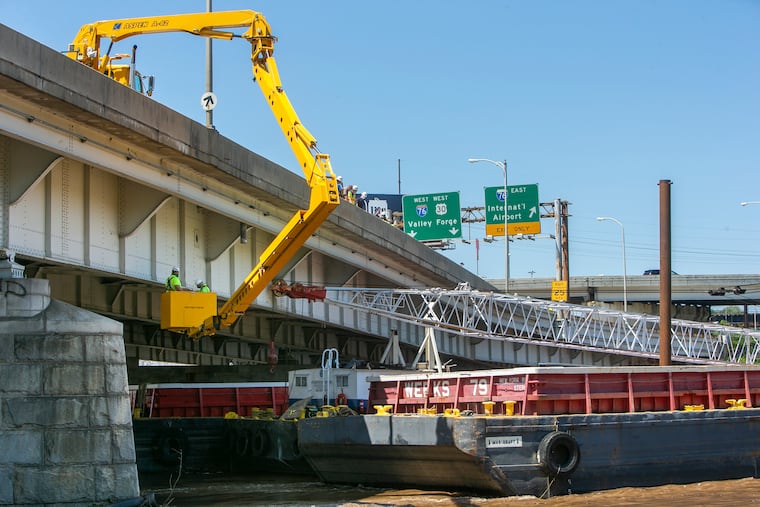The Vine Street bridge took a hit from a 100-ton barge, but is deemed OK
PennDOT officials hope to open the expressway ramp Thursday.

A 100-ton barge and two sister vessels were torn loose from their moorings in the fast-rising Schuylkill late Tuesday afternoon and drifted downstream to hit a bridge that funnels cars off the Vine Street Expressway.
Yet despite sustaining what a Drexel University engineering professor called the impact of “phenomenal” forces, the bridge seemed sound during inspections Wednesday and was to be reopened Thursday, PennDot and city officials said.
Torrential rain swelled the river’s volume to more than 60 times what it had been less than two days earlier, speeding the current to about 4.5 mph, according to the U.S. Geological Survey.
The rising water dislodged the C.B. Lehigh along with two hopper barges, which contractor Atlantic Subsea Inc. of Bridgeton, N.J., was using to dredge years of silty buildup from the river in front of Boathouse Row and along the regatta racecourse further upstream.
The Lehigh and its sister vessels drifted for several hundred feet before hitting the bridge — an impact that could have caused structural damage, said Drexel’s Joseph Martin.
“I’m pretty sure there were some phenomenal forces,” he said.
Yet when inspectors descended in a bright yellow crane to peer at the bridge’s massive steel beams and concrete piers up close, they deemed all to be well, said PennDot District 6 executive Kenneth M. McClain.
A metal “stiffener bracket” sustained minor damage but can easily be repaired and will not prevent the structure from reopening safely, he said at a news conference with Mayor Jim Kenney and other government officials Wednesday.
“There were some minor structural issues that were discovered with the bridge, but nothing that compromises the structural integrity of the bridge itself,” McClain said.
The dredging began in early June, with the goal of removing 60,000 cubic yards of sediment that has created hazards for rowers and threatened famed regattas such as the Dad Vail. In preparation, docks along Boathouse Row were removed for the first time in a century.
The Schuylkill Navy, an association of amateur rowing clubs, raised funds to help pay for the dredging to avoid having regattas canceled because of sediment buildup. Though the effort began years ago, it ran into a roadblock this spring with the coronavirus pandemic shutdown.
The contract was awarded to Atlantic Subsea by the Army Corps of Engineers. The company was dredging roughly three miles of the Schuylkill in stages, including in front of Boathouse Row, a separate rowing lagoon, and the national racecourse near the Strawberry Mansion Bridge. The sediment was being pumped via pipe downstream to the barges, which in turn carried it for disposal at Fort Mifflin.
The barges were not in use when they came loose Tuesday. They were moored with stout “spuds” — metal posts anchored to the river bottom.
Army Corps officials said there was no indication the contractor had moored the barges improperly, saying the rising waters were too much for them to stay put. The boathouses had damage as well, said Bonnie Mueller, vice commodore of the Schuylkill Navy. Water entered the buildings, and docks had to be disassembled and moored at the Playing Angels statue, a little more than a mile upstream, and above the Girard Avenue Bridge.
The river’s average flow is less than 2,000 cubic feet per second where the barges were moored, yet by the time they came loose late Tuesday afternoon, volume had reached 60,000 cubic feet per second and would exceed 70,000 before day’s end, according to the Geological Survey.
That equates to a river velocity of about 4.5 mph, said A. Thomas Ruby III, acting associate director for data programs at the agency’s Pennsylvania Water Science Center.
Tugboats will be used to free the barges when high water subsides, said Lt. Col. David C. Park, commander of the Army Corps’ Philadelphia district. And if all goes well, cars will be allowed back on top Thursday.